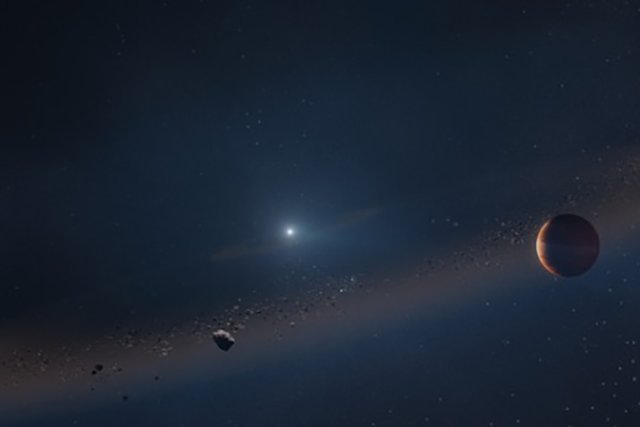

A team of astronomers found the remains of a dead star, known as a white dwarf, with a surviving exoplanet that resembles Jupiter.
The team used a technique called microlensing, in which astronomers wait for two stars to line up perfectly as viewed from Earth and watch to see how the light from the distant star is bent by the gravitational pull of the closer one.
White dwarfs are small stars that are slowly cooling off because they no longer burn nuclear fuel. As they near death, stars like our Sun will expand into a red giant, then eject their outer layers leaving only a small, dense core: the white dwarf. This remnant represents “what we think will happen to our solar system in about eight billion years,” says Joshua Blackman, an astronomer at the University of Tasmania who led the study. The findings were published in the journal Nature.
As the sun grows into a red giant it will “obliterate Mercury and Venus and quite possibly earth as well on the way,” before it shrinks to a white dwarf, Blackman says.
Microlensing requires looking at how light that passed a star has been distorted. In looking at how a star changed the passing light, astronomers can figure out “the geometry of the system,” learning about the mass of a star and potentially the exoplanets that orbit it, Blackman says.
It is an indirect way to make a measurement, but “the team did a very thorough analysis” and the study was convincing, says Dániel Apai, an astronomer and planetary scientist at the University of Arizona, who was not involved with the study. Apai heads NASA’s Alien Earths project for exoplanet study.
The microlensing, which took place in 2010, required a network of telescopes, and though that data told the team about the mass of the star and its exoplanet, it didn’t provide a direct picture. So, the team followed up years later with the Keck Observatory in Hawaii—which houses one of the largest optical telescopes in the world—to try and observe the star itself. The team had to wait until the conjunction (which had allowed the microlensing) was over and the two stars got far enough apart in the sky so they could get a clear look at each, which would sort out how bright and how big they are.
From the microlensing data, the team got “a very strong indication that there’s about a Jupiter mass planet there with a star,” Blackman says. But perplexingly, using the Keck Observatory, they couldn’t spot the star.
The telescope should have been powerful enough to see any typical star at that distance. Eventually, they realized that the fact that they couldn’t detect the star wasn’t a failure in the equipment—it meant that the star was simply too dim to see. That left only a few explanations.
“It could either be a white dwarf,…a black hole, or a neutron star,” Blackman says. But the microlensing observation showed the object should be less than the mass of our Sun, and there’s no known way for a black hole or neutron star to form that small, so a white dwarf was by far the best explanation, he says.
In the future, the team hopes to observe the white dwarf directly with the Hubble or James Webb Space Telescope, Blackman says, both of which “see deep enough into the sky that we will be able to directly look at the light from the white dwarf.”
But why is spotting a planet around a white dwarf special?
First, it’s rare. This is the first time microlensing has been used to find a white dwarf and only the fifth white dwarf ever to be found with an exoplanet, according to Blackman.
And as a window into our future, none of the other white dwarfs make for a convincing solar stand-in. Two of the exoplanets are very close to their white dwarfs—only a fraction of the distance at which Mercury orbits our sun, Blackman says. Astronomers don’t know how they got there, but our planets aren’t nearly so cozy with our Sun.
[Related: White dwarf star spotted nibbling on the atmosphere of a nearby icy planet]
Another exoplanet orbits a white dwarf and a pulsar, or pulsating neutron star. Cool, but not what’s in our backyard. The last planet orbits so far away from its white dwarf astronomers aren’t even sure if it belongs to that star at all, Blackman says, so none are a good match.
The system Blackman’s team found is a lone star with a gas giant about 40 percent larger than Jupiter that’s traveling in a roughly similar orbit to it. The planet appears to have survived the death of the star “more or less untouched,” Blackman says. The find is the first concrete evidence to the idea that our outer planets could survive the death of the sun.
“We expect that Jupiter and Saturn will survive [the death of the Sun], but we didn’t have direct evidence of this being the case,” Blackman says. If Earth hasn’t yet been destroyed by eight billion years’ time, “it will be full of lava lakes and very inhospitable.”
This glimpse of a white dwarf is a kind of trial run, he says, “this is the first detection of a white dwarf planet using microlensing” but with the Roman Space Telescope, planned for the mid-2020s, scientists hope to find hundreds.